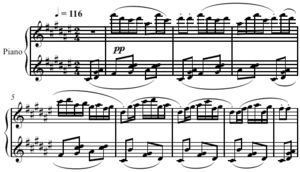Ma mère l'Oye facts for kids
Ma mère l'Oye (which means Mother Goose in French) is a famous musical piece. It was created by the French composer Maurice Ravel.
This music started as a five-part piano duet in 1910. A piano duet means two people play on one piano. In 1911, Ravel changed the music for a full orchestra. This is called orchestration.
Contents
Piano Versions of Mother Goose Music
Maurice Ravel first wrote Ma mère l'Oye for two young children. Their names were Mimi and Jean Godebski, and they were 6 and 7 years old. Ravel dedicated this music to them. He had also dedicated an earlier piece, Sonatine, to their parents.
The first time this music was played in public was on April 20, 1910. It was performed by Jeanne Leleu and Geneviève Durony.
Ravel's friend, Jacques Charlot, later made a version for just one piano. This happened in the same year, 1910. Both piano versions are called "five children's pieces."
The Five Children's Pieces
The five parts of Ma mère l'Oye are based on classic fairy tales:
- Pavane de la Belle au bois dormant: This is a slow dance (a Pavane) for Sleeping Beauty.
- Petit Poucet: This piece is about Tom Thumb (or Hop-o'-My-Thumb).
- Laideronnette, impératrice des pagodes: This means Little Ugly Girl, Empress of the Pagodas. It's inspired by a tale called The Green Serpent.
- Les entretiens de la belle et de la bête: This is a waltz about the Conversation of Beauty and the Beast.
- Le jardin féerique: This means The Fairy Garden. It's a slow and serious piece.
The stories of Sleeping Beauty and Little Tom Thumb come from Charles Perrault. The story of Little Ugly Girl comes from Madame d'Aulnoy. The Beauty and the Beast part is based on the version by Jeanne-Marie Le Prince de Beaumont. The exact origin of The Fairy Garden is not fully known. However, in the ballet version, it shows Sleeping Beauty waking up in the garden.
Ravel sometimes added quotes to his music scores. These quotes helped explain what he wanted the music to sound like. For example, for the Petit Poucet piece, he included this quote:
He believed he'd easily find his way because of the bread that he'd strewn all along his path; but he was very surprised to find not a single crumb: the birds had come and eaten everything.
—Charles Perrault
Orchestrated Version of Mother Goose
In 1911, Ravel arranged the five piano pieces for a full orchestra. This orchestral version is the one most often heard today.
Later in 1911, Ravel expanded the music even more. He turned it into a ballet. He added four new short musical parts called "interludes." He also added two new movements at the beginning: Prélude and Danse du rouet et scène.
The ballet was first performed on January 29, 1912. It took place at the Théâtre des Arts in Paris.
The Eleven Ballet Numbers
The ballet version has eleven parts:
- Prélude – Très lent (Very slow introduction)
- Premier tableau – Danse du rouet et scène (Spinning wheel dance and scene)
- Deuxième tableau – Pavane de la belle au bois dormant (Sleeping Beauty pavane)
- Interlude
- Troisième tableau – Les entretiens de la belle et de la bête (Dialogues of the Beauty and the Beast)
- Interlude
- Quatrième tableau – Petit Poucet (Hop-o'-My-Thumb)
- Interlude
- Cinquième tableau – Laideronnette, impératrice des Pagodes (Empress of the Pagodas)
- Interlude
- Sixième tableau – Le jardin féerique (Fairy Garden)
Instruments in the Orchestra
Ma mère l'Oye uses many different instruments. Here are the instruments Ravel chose for the orchestra:
|
|
See also
 In Spanish: Mi madre, la oca para niños
In Spanish: Mi madre, la oca para niños


